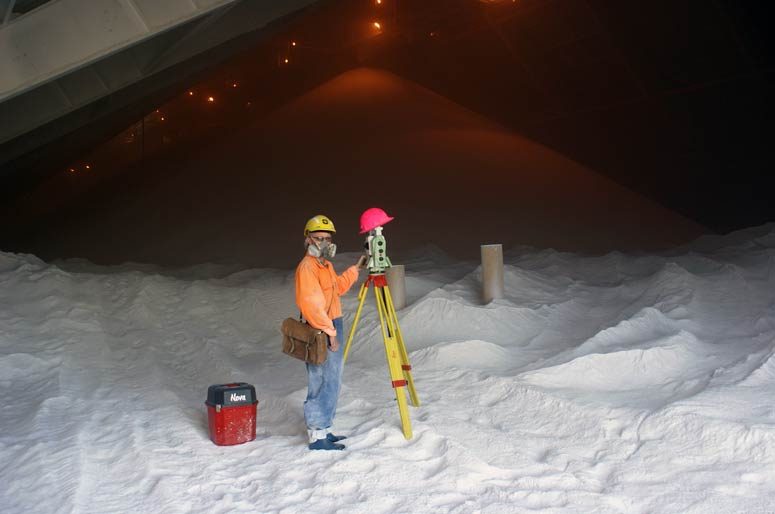
THE CHALLENGE: Scan the highly hazardous and dusty stockpiles at NZAS industrial site
New Zealand Aluminium Smelters (NZAS) is New Zealand’s only aluminium smelter and is located on Tiwai Peninsula. NZAS needed to know the volume of alumina they have in store at a given point in time for audit purposes, and Don Moir from Ralph Moir and Associates was hired.
The site had significant technical challenges:
• The stockpile was extremely complex in shape with a series of ridges and gullies in 3 fan shapes plus numerous small heaps from the new material dropped from above.
• Restricted access due to safety concerns and dusty environment makes for a very challenging survey. The dust is so thick visibility is about 50m at most.
THE SOLUTION: Leica MS50 was used to scan for safety and greater speed and accuracy
Safety is the primary concern with any activity on the NZAS site. Don says “The use of the Leica scanner allows me to survey most of the store remotely from the catwalk above although some areas remain hidden from the catwalk and must still be surveyed at ground level. The alumina forms unstable slopes within the stockpile that can collapse resulting in a significant safety hazard so that ground entry to the store is heavily restricted.” Two surveyors were killed undertaking the same activity in one of Comalco’s smelters in Australia, so the hazard is very real.
Moir said “What really impressed me about the MS50 is its ability to penetrate the dust and still provide very reliable data. The robotic total station used previously was limited to about 40m and would produce false readings beyond that due to the reflected signal from the dust. I have found that the MS50 is easily capable of well over 100m and is thus surveying parts of the stockpile that are invisible to me due to the dust.”
THE RESULT: Cut down critical survey time, increased safety and greater precision
The overall time saving on a survey is yet to be fully realised but Moir says it should be a reduction from about 7 to 5 hours. This in itself may not seem much but to NZAS it is significant as their extraction system has to be shut down for the survey and there is limited ability to store alumina elsewhere on site so that every hour is critical. The two main benefits for NZAS are the increased safety in that very little work has to be done at ground level in the store and the increased precision of the end result. In the past Don would typically collect about 3000 – 4000 spot heights from which his model was created. Don now collects about 200,000 and could obviously collect more if I desired.
Moir purchased Leica theodolite and MS50 total station for specialised laser scanning from Global Survey. He says “Leica have a reputation for quality and reliability and have always met with our expectations going back to when we first started in about 1955.


